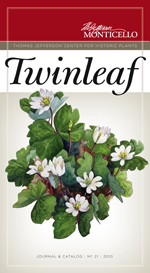
A new and interesting species grown in the Monticello gardens in 1995 was "McMahon's Texas Bird Pepper," a pretty little plant with a compact habit and showy, but tiny, orangish-red fruits described by Thomas Jefferson as "minutissimum."
Jefferson obtained seed of the Bird Pepper (Capsicum annuum var. glabriusculum) in 1812 and 1813 from Captain Samuel Brown, who was stationed in San Antonio, Texas. Jefferson reported sowing "Capsicum Techas" in pots and in a row in Square XII of his kitchen garden on March 26, 1814.
Brown said this species, a native of southwest Texas, Mexico, and Central America, had potentially important medicinal qualities, particularly for "disorders of the ailmentary canal," and noted how the peppers were often added to vinegar "to communicate a fine aromatic flavor." Brown added, "The Americans . . . make a pickle of the green Pods with Salt & Vinegar which they use with Lettuce, Rice, Fish, etc. I find this taste growing so fast that it will soon become as essential to my health as salt itself." Jefferson himself had high hopes the Bird Pepper would prove hardier than other species, and forwarded seeds to his favorite nurseryman, Bernard McMahon, in 1813. An oral history tradition credits McMahon with a central role in popularizing the species throughout southeastern Pennsylvania.
We were sent seeds of the Bird Pepper in 1994 by William Woys Weaver, a Pennsylvania food historian. Weaver said, "Old Philadelphians used the potted peppers as a winter table ornament or as windowsill plants. The peppers themselves were used to make pepper vinegar, pepper sauce, or pickles." Mr. Weaver obtained seeds in 1975 from Mary Larkin Thomas, a descendent of Dr. George Thomas (1808-1887), an active plantsman from Chester County, Pennsylvania who preserved the seed because of its association with Thomas Jefferson and Bernard McMahon.
In its native habitat, the Bird Pepper—known as Chiltecpin (Chill-tech-peen) to the pre-Columbian Nahuatl people and the first Spanish plant collectors—is a low shrub to five feet in height. Jean Andrews, in Peppers, The Domesticated Capsicums, reported that, "Originally, the Nahuatl [Amerindian tribe] word meaning flea was applied [to the Bird Pepper] because of the similarity in size and bite." In Mexico, the flavor is described as "'arrebatado', an expression that means 'although it is extremely hot the sensation disappears easily and rapidly."' Chiltepins, as they are known today, are still harvested in the wild and sold in Mexican markets. According to Dr. Andrews, "During the time of year when they are ripe they are favored by the people of Mexico over all other types of chiles."
McMahon's Texas Bird Pepper seems like a dwarf version of the wild Chiltepin. We've been captivated by its ornamental possibilities: a tidy, compact mound (eight to twelve inches) of rich green foliage capped with petite (quarter-inch), sparkling red, berry-like peppers. Mature plants resemble a vivacious, dwarf form of Jerusalem Cherry (Solanum pseudocapsicum) and are ideally suited for growing in pots.
Peter J. Hatch, Director
Monticello Gardens and Grounds
January 1996